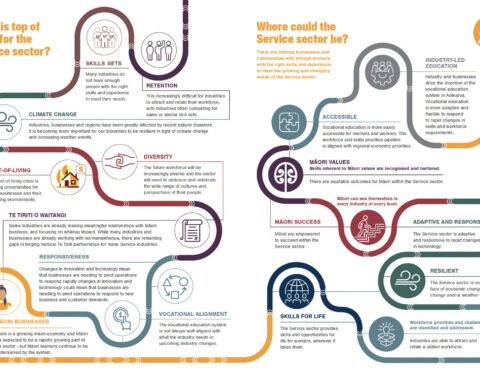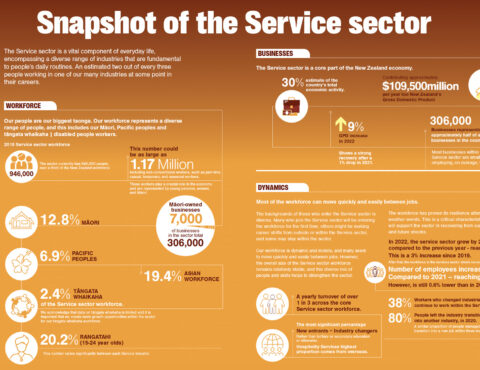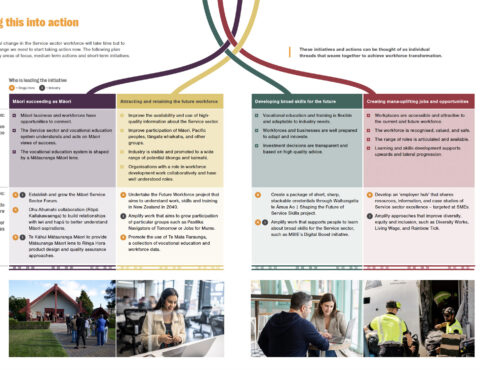Workforce development plays a pivotal role in bolstering industry resilience, particularly in the face of recent extreme weather events and looming economic uncertainty. These challenges underscore the need for a skilled and adaptable workforce that can effectively navigate disruptions and contribute to the overall sustainability of industries.
This Workforce Development Plan presents a high level summary of what’s top of mind for the Service sector – it complements the Individual Industry Action Plans to outline the actions we could take to strengthen the future workforce.
These reflect future aspirations and are built on actions that are driven by people from across the sector. Each of these aho will strengthen the workforce, and when these aho are woven together as a taura whiri | rope, these aho will guide us to achieve real transformational change.




To make this a reality, the Workforce Development Plan needs to be driven by people who know the Service sector best – people like you. By continuing to work together, we can grow knowledge and understanding of the sector and its industries and create real change.

The future of the Service sector is an exciting one. It’s a future that has people at the centre – with endless possibilities for people to choose their own path. It’s a future in which industry and businesses can thrive and are empowered to determine their own direction.
A flourishing Service sector is one that reflects the communities it serves. New Zealand’s future population is becoming increasingly diverse. There is a rapid growth in the Māori, Pacific, and Asian population, changing views about gender, and a wider range of cultures and perspectives. Embracing and celebrating our growing diversity will help industry access growing numbers of potential kaimahi and will create a point of genuine differentiation which will encourage more business opportunities here and abroad.
The future will bring significant growth of Māori business in the Service sector. The manaakitanga that has always been at the heart of the Service sector will be bolstered by increased use of Te Reo and embracing of Mātauranga Māori in businesses across the sector.
Industries give action to increasing Māori access and have meaningful maintained relationships with Māori industry.
More and more people are seeking opportunities to engage in meaningful and rewarding work that includes opportunities for development and progression. The role of work in people’s lives is changing, more noticeably since the COVID-19 pandemic. The gig economy is likely to grow and workplace practices will continue to adapt to enable a range of flexibility about when, where and how they are working.
Values and inter-generational wellbeing will be at the heart of many business, workforce, and consumer decisions. People are increasingly conscious of social, cultural, and environmental impacts and consider how today’s decisions affect future generations. Increasingly, people are looking for social enterprises and organisations which prioritise mental health and wellbeing and pay a Living Wage.
Trends such as digitisation and environmental sustainability create an opportunity to rethink what the Service sector workforce could look like now and in the future. These changes will shift the tasks people do and the range of skills they need.
Like all good visions, this exciting future for the Service sector won’t happen by accident. Skills shortages are likely to be a real struggle for a while. However, the choices and actions we each take now will play a significant role in helping shape the future of the sector.

There are thriving businesses and communities with enough workers with the right skills and experience to meet the growing and changing needs of the Service sector.

The Service sector is a vital component of everyday life, encompassing a diverse range of industries that are fundamental to people’s daily routines. An estimated two out of every three people working in one of our many industries at some point in their careers.
Explore the Service sector snapshot to view details about the workforce, businesses and dynamics.
A key lever to promote skills in the workforce is through an effective vocational education and training system.
Industry has a role to play in encouraging more of the workforce to engage in relevant training and qualifications and get the required skills that industry is looking for.

More recognition of on job training and qualifications, encouraging credentialisation of training and supporting employers to invest more in their people is critical to uplifting the skills of our Service sector workforce and tackling this skills shortage across all sectors.
With rapid changes in work environments and people moving across different roles, it is increasingly important for industry to recognise previous skills and experience of kaimahi. Currently a lot of training is delivered on the job and this experience is not always recognised or credentialised. However, as people are more likely to work in multiple roles and industries through their careers, credentialising on-job training or acknowledging micro-credentials could form an important lever in rapidly matching people into roles and support kaimahi to progress within their careers wherever they go.
The demographics and other characteristics of our workforce are dynamic – whether that’s in terms of ethnicity, age, gender, or the experience of a disability.
By 2038, more than 50% of our workforce will be Māori, Pacific, or Asian, which will have significant implications for our services. At the most basic level, it will change who services are delivered for and by. That, in turn, carries different expectations of what the Services could or should look like.
Each of these groups makes a unique contribution to the Service sector, and businesses will benefit from recognising this contribution and being responsive to their individual needs. With current labour shortages, developing a committed and responsive relationship with these groups will help realise the proven economic and social benefits for employers, the workforce, and the wider communities in which services are delivered.
What follows is some information about the characteristics of selected population groups in the Service sector and what we’ve heard about things that are top of mind for these groups. The groups listed have been covered as these are three priority learner groups recognised by the Tertiary Education Commission and Ringa Hora.
We want to build a resilient and capable workforce that enables economically, socially, and culturally thriving people, businesses, and communities.
We have identified four key aho|strands, that are important for developing the workforce. Each of these aho will strengthen the workforce, but when woven together, as a taura whiri, we can achieve real transformation of the workforce.

Māori success is fundamental to the success of the Service sector. Māori business is thriving, Māori culture is increasingly being embraced, and Māori are experiencing strong population growth and making up a larger share of the young workforce. In this context, creating an environment where Māori succeed as Māori will benefit individuals, businesses, and the Service sector as a whole.

The Service sector is facing sustained skill and labour shortages, with some industries facing more extreme shortages while others were forced to make staff redundant. Looking forward, we anticipate the labour market will remain tight, and the Service sector will need to continue to work hard to attract the workforce needed for the future.

It is critical that people in the sector have the skills that will help individuals and businesses thrive now and in the future. As work is changing rapidly, people need a strong base of core skills, including literacy, language, and numeracy, as well as a broad range of skills that enable them to be adaptable and responsive and give them the ability to continue to learn throughout their lives.

The Service sector has a huge variety of roles ranging from highly skilled, highly paid roles to those that have traditionally been very low paid and seen as very low skilled.
As a result of COVID-19, it has become clear that many Service sector roles like cleaners and supermarket shelf stockers, who have previously been taken for granted, are critical to New Zealand on a day-to-day basis. There is a significant opportunity to maintain and build the mana of people in these roles, increase the pay they attract, and recognise the opportunities they offer.

Transformational change in the Service sector workforce will take time but to achieve that change, we need to start taking action now. Download our action plan which includes the key areas of focus, medium-term actions and short-term initiatives.
The Workforce Development Plan looks across the Service sector and sets out the major factors shaping the sector and an overarching vision for the future.
Sitting alongside this are nine Workforce Action Plans which focus on the characteristics and dynamics of each individual industry and its workforce. They describe what the future could look like for the workforce, the current challenges faced by the industry, and sets out the actions we can take to tackle this wero | challenge.
What Ringa Hora is doing:
Ringa Hora has been mandated, through the Reform of Vocational Education (RoVE), to not only support the creation of a workforce development plan but to actively participate in delivering its vision. We will do this through a number of actions, including:
1. Producing an annual progress update on sector and industry specific workforce actions:
This report will provide an update on where actions are at and track progress.
2. Engaging with industry throughout the year ahead of this annual progress update:
We’ll be reaching out to you in different ways, including arranging hui and attending industry events, but we also encourage you to get in touch with us directly.
3. Publishing the next iteration of the Workforce Development Plan mid-2024:
This will be informed by quantitative information and qualitative insights gleaned from engagements with industry, education providers and people within the sector.
How you can implement actions from the workforce development plan in your business:
◘ Partner with us on workforce initiatives:
If you are not already and would like to partner with Ringa Hora on any of the actions in this plan or the industry specific action plans, please get in touch with us.
◘ Tell us what is working and what isn’t:
It’s important for us to hear your views about what’s in this plan. This will help us all be confident that future plans best reflect Service sector needs and aspirations and include actions that are meaningful, action-oriented, and sustainable.
◘ Report to us on sector and industry specific workforce actions progress:
This will help us to advance, track and report on the workforce development actions and deliver on Service sector needs and aspirations.
◘ Engage with us more:
We also encourage you to get in touch with us directly to engage on any of the workforce development actions or to share information on any products/initiatives in these plans, the industry and workforce data that we have used and any upcoming engagements which you can be a part of.
◘ Use the products or initiatives listed in the sector workforce plan.